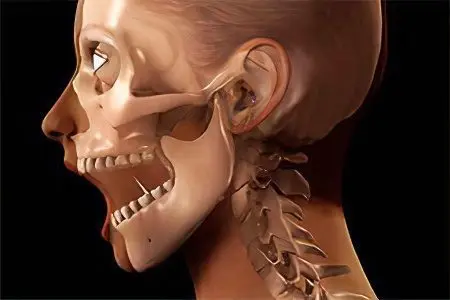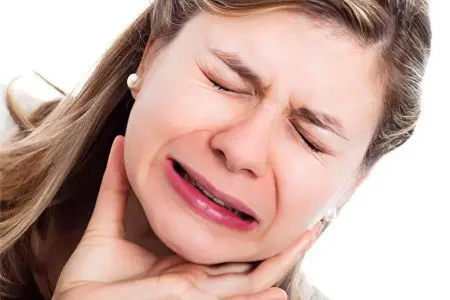Contents
What is a jaw dislocation?
Dislocation of the lower jaw occurs due to the pathological displacement of the head of the joint from its usual location. This disrupts the normal functioning of the jaw, limiting its movement and causing pain.
Dislocation of the jaw concerns only its lower part, because the upper jaw is motionless. The lower jaw is attached to the temporal bone by a special paired temporomandibular joint. It is he who sets the lower jaw in motion.
The head of the joint may slip out of its normal position, being in front of the tubercle of the temporal bone. This happens due to sharp movements of the jaw or under the influence of an external force on it.
According to research findings, jaw dislocation is diagnosed more often in women than in men. This fact is explained by the structural features of the temporomandibular composition. The articular fossa in men is deeper, so the joints are fixed more securely and it is more difficult to displace them. When dislocated, the head of the joint moves forward. In some cases, it may be shifted in other directions: back or to the side.
Dislocation, depending on the causes and nature of the damage, affects either one side of the jaw or both. Therefore, when diagnosing, it is necessary to do a full x-ray of the facial part of the skull. Having received a dislocation of the lower jaw, you should seek help from specialists as soon as possible. After all, it leads to serious consequences: weakening of the ligamentous-capsular apparatus, deformation of the articular elements, changes in the structure, size and shape of the discs located between the joints.
Causes of jaw dislocation

Dislocation of the lower jaw can occur due to screaming, violent yawning, while eating or vomiting, that is, at those moments when the mouth opens sharply and widely (trying to bite off too much of a piece of food can also cause jaw dislocation.). Bad habits of opening bottles or packages with your teeth can also be harmful, straining your jaw unnecessarily.
It is not uncommon for it to be damaged by a strong blow. Professional athletes – wrestlers and boxers – face dislocation of the lower jaw. You can cause a displacement of the articular head by biting too hard and hard food, for example, a nutshell. To protect the jaw from damage, you should avoid too sudden and rapid movements during yawning and chewing.
Dislocation of the lower jaw can also be non-traumatic. For example, some diseases, including rheumatism, gout, osteomyelitis, polio, arthritis, or arthrosis, cause ligaments to relax, resulting in a decrease in the height of the joint, and its shape is deformed.
In women, due to the shallower depth of the articular fossa, it is easier to displace the head of the joint. Accordingly, a dislocation of the jaw occurs in them much more often than in men.
Jaw dislocation symptoms
Regardless of the type of jaw dislocation, there are several common symptoms that help identify it. These include difficulty opening and closing the mouth, protrusion or distortion of the lower jaw relative to the norm, speech difficulties, severe salivation and sharp pain in the lower jaw, radiating to the temple.
In addition, dislocation of the jaw is accompanied by severe pain in the parotid region, as well as in the region of the lower jaw. The patient loses the ability to speak articulately because he cannot close his mouth. There is increased salivation. Depending on the type of dislocation, the pain may cover only one or both sides of the skull. Outwardly noticeable changes in the position of the lower jaw. It can be pushed forward or skewed.
It is possible to diagnose a dislocation of the jaw with an external examination, but in order to differentiate it from a fracture, an X-ray examination is necessary.
It will not be possible to straighten the jaw with a dislocation on its own. It is necessary to contact specialists as soon as possible. However, as a first aid, cover the patient’s mouth with a handkerchief to prevent dust and foreign bodies from entering it. The jaw can be temporarily supported with a bandage. Applying cold helps relieve pain.
Types of dislocations of the jaw

Dislocations of the lower jaw are classified according to various criteria. For example, dislocations can be unilateral or bilateral:
Bilateral. In most cases, bilateral dislocation occurs. In this case, the person’s mouth opens completely, and the jaw moves forward. There is also profuse salivation, difficulty in swallowing and speaking.
Unilateral. Unilateral dislocation of the jaw is more rare: the head of only one joint moves out of its normal position, as a result of which the mouth opens slightly, and the jaw shifts to the healthy side.
Full. Also, dislocations can be complete (articular surfaces do not touch) and incomplete (surfaces partially touch).
Incomplete. Incomplete dislocations are called subluxations. If the jaw dislocation is accompanied by a rupture of soft tissues (skin, tendons, blood vessels), it is called complicated. When there are no gaps, they speak of a simple dislocation. Depending on whether the head of the joint has shifted forward or backward, dislocations are divided into anterior and posterior.
Habitual. If a dislocation of the lower jaw can cause slight yawning or slight pressure on the jaw, it is called habitual. Anatomical features of the temporal bone lead to its occurrence. Habitual dislocation of the lower jaw is possible with a flat articular tubercle or head. Often it is detected when the ligamentous apparatus of the joint is weakened or the articular bag is stretched. All these factors lead to the fact that during yawning or sneezing, the head changes its position and a habitual dislocation is formed. Unlike all other types of dislocations, you can cope with it yourself. But only surgical intervention helps to prevent subsequent displacement of the articular head. To cope with habitual dislocation, an increase in the height of the articular tubercle or depth of the articular cavity, strengthening of the articular capsule is performed. In some cases, it is possible to create an additional support for the articular head, which allows you to fix it in the desired position.
Rear. The cause of such a dislocation is, as a rule, a blow falling on the chin. The lower jaw moves back. Posterior dislocation is dangerous, as it leads to rupture of the joint capsule and damage to the bone wall of the ear canal. As a result, the patient may experience ear bleeding.
Diagnosis and treatment
The doctor will be able to confirm the presence of a dislocation by performing an x-ray. After the diagnosis, the jaw is repositioned. This procedure is performed under local anesthesia.
First of all, the treatment of a dislocated jaw consists in repositioning the jaw joint to its usual place. This should be done by a doctor, but before hospitalization, first aid measures must be taken by fixing the jaw with a handkerchief. After the dislocation is reduced, a tight immobilizing bandage is applied to the victim, which immobilizes the jaw for one to two weeks. At this time, you need to give up solid food, giving preference to soups and pureed cereals.
The reduction of the posterior dislocation is carried out similarly, only the thumbs are located behind the wisdom teeth. After the procedure, the doctor applies a bandage, which will have to be worn for several weeks. Habitual dislocation can be treated surgically, but if it is caused by other diseases, it is necessary to treat them.
Chronic dislocations of the jaw are reduced under anesthesia (general or local), and they are treated longer: it takes up to three weeks to wear a fixing bandage or special orthopedic devices. In general, the outcome of this disease is favorable. Only in particularly severe cases, an operation may be necessary, after which there is a likelihood of difficulties in the mobility of the lower jaw.
During the recovery period after damage to the lower jaw, you should not eat hard and hard food. It is recommended to use cereals, puree soup and other soft foods. You can not open your mouth wide, so you should suppress a yawn, do not scream. Habitual dislocation can be caused by a large amount of food in the mouth, so you need to eat slowly, biting off small pieces.









